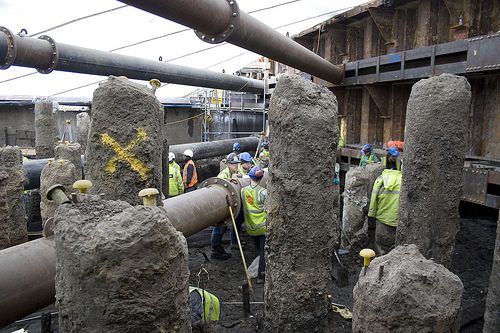A number of Roman tablets found while excavating a new tube station entrance have been shown to contain the oldest known reference to the city of London, as well as a wealth of information about the Roman occupation of the city.
Discovered whilst excavating the site of Bloomberg’s new HQ, the remains were in a section of the building site which had survived the earlier 1960s clearing of the site. It also happens to be where the new entrance to Bank tube station is being constructed.
Addressed to Mogontius, a Celtic personal name, this is the earliest reference to London
Romans all over the Empire used waxed writing tablets like paper, for note-taking and accounts, for correspondence and for legal documents. Previously only 19 legible tablets were known from London. Of the 405 from Bloomberg, 87 have been deciphered, more than quadrupling that number and providing an incredibly rare and personal insight into the first decades of Roman rule in Britain.
In the words of the people who lived, worked, traded with and administered Roman London, the tablets reveal the names, events, workings and organisation of the new city. One tablet features the earliest ever reference to London, a full 50 years before Tacitus wrote about London in his Annals.
Highlights from the writing tablet collection include:
- The earliest dated hand-written document known from Britain, a financial document of 8 January AD 57;
- A tablet archaeologically dated to AD 43-53, the first decade of Roman rule in Britain;
- The earliest reference to London, dated to AD 65-80;
- Evidence of someone practicing writing the alphabet and numerals, perhaps the first evidence for a school in Britain;
- New evidence for Julius Classicus, a figure later known to history as a leader of the Batavian revolt, revealed to be the prefect of the Sixth Cohort of Nervians in the first decades of Roman London;
- A contract from 21 October 62 AD to bring ‘twenty loads of provisions’ from Verulamium to London by 13 November, a year after the Boudican Revolt, the tablet reveals precious details of the rapid recover of Roman London;
- The names of nearly 100 people, from a cooper, brewer and judge, to soldiers, slaves and freedmen. The names reveal early London was inhabited by businessmen and soldiers, most likely from Gaul and the Rhineland.
Made of wood, recesses in the rectangular tablets were originally filled with blackened beeswax, with text inscribed into the wax with styluses. Although the wax hasn’t survived, the writing occasionally went through the wax to mark the wood. As tablets were reused, in some cases several layers of text built up on the tablets, making them particularly challenging to decode.
Britain was invaded by the Romans in AD43 and this tablet dates to the first decade of their rule
The preservation of the tablets is in itself remarkable, as wood rarely survives when buried in the ground. The wet mud of the Walbrook, a river that dominated the area in the Roman period but is now buried, stopped oxygen from decaying the wooden tablets, preserving them in excellent condition.
Once excavated, the fragile tablets were kept in water before MOLA conservators cleaned them and, using a waxy substance, PEG, which replaced some of the water content, treated them before they were freeze-dried.
The research has been published today in a new research book.
Over 700 artefacts from the Bloomberg excavation will be displayed in a public exhibition space that will sit within the new Bloomberg building, including the earliest-dated writing tablet from Britain.
The London Mithraeum exhibition, which includes the restoration of the Mithas Temple opens in autumn 2017.










wonderful & amazing
What a shame the building of another City building takes priority over preserving this site. It could be our Roman Forum in London! Money talks though! Bloomberg even get to their name to be used in the find- the nerve!
There’s nothing on the site to preserve and show off though — in the 1950s, most of the site was gutted by unthinking bulldozers, and the one small corner that did survive was punched through all over the place with concrete piles.
What has survived are fragments — extremely valuable fragments — but that’s all.
A visitor centre of the excavation site would be just a mud-pit. Not particularly exciting to look at, except to mud enthusiasts. Much better is the planned visitor centre with the Temple of Mithras restored and the objects on display.
OMG, that’s when I lost my virginity.
Roman London? You’re holding up well, I must say.